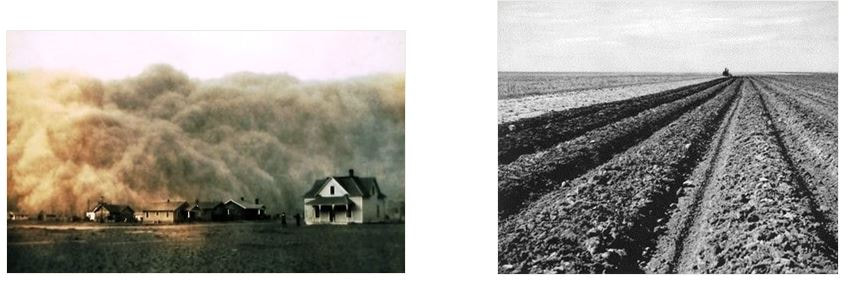|
During most of the 1930s, the Great Plains region of the United States was devastated by drought and high winds. This area became known as the “Dust Bowl”. Howling winds also whipped up the topsoil of over-farmed land creating “black blizzards” that were so thick and blinding that daylight seemed more like dusk. It is estimated that these “black blizzards” displaced over 300 million tons of topsoil from the prairie area. These horrendous storms also forced 2.5 million people to migrate west only to encounter extreme disappointment and discrimination.
Why did these storms happen? The U.S. Government during WWI encouraged farmers to support the war effort by planting wheat to feed the soldiers overseas. In order to increase food production, farmers in the Midwest dug up the buffalo grasses that had held down the prairie soil for thousands of years through their extensive root systems. With the invention of the farm tractor, farmers could plow up thousands of acres of grassland and plant wheat. Livestock grazed on the rest of the land destroying the natural system that had preserved soil on the prairies. When a drought occurred, the deep roots grounding the prairie grass, were gone. One powerful windstorm after another swept across the “Dust Bowl”. The dry topsoil rose in towering clouds and rolled across the land, blotting out the sun sometimes for days at a time. These “black blizzards” made life almost unbearable. People developed “dust pneumonia” and suffered with pain and difficulty breathing, causing many people to die. Dust drifted like snow so residents had to clear it with shovels. Sometimes people had to dig out their whole homes. It went through the cracks of even well-sealed houses, leaving a dusty coating on food, skin, and furniture. Dust and sand also damaged car engines and farm equipment. Cows and other grazing animals ate the dust-coated grass which created “mud balls” in their stomachs leading to death. One major “black blizzard” occurred on May 11, 1934. The storm was two miles high and traveled 2,000 miles to the East Coast blotting out views of the Statue of Liberty and the U.S. Capitol. Sailors 300 miles into the Atlantic Ocean reported dust ½ inch thick on the decks of their ships. This nightmare lasted almost 10 years when, finally in 1939, the much needed rain came, bringing hope to the prairie. A federal program encouraged farmers to utilize new farming methods that would protect topsoil from eroding. Consequently, Americans should never have to experience the horror of “black blizzards” again.
0 Comments
Be sure to remove any leaves, dead plants, or other plant debris from the garden. You don’t want to draw pests to your soil or leave diseased plants to compost in your garden over the winter, potentially damaging your soil.
September is a month where many annuals will begin to dry up. When this starts to happen, let them. You can collect the seed pods they produce and store them for next year. Be sure to allow the pods to dry out fully before storing. Also, be sure to store them in a cool, dry location to keep the seeds intact. English ivy drastically reduces mold indoors. It’s a good plant for your desk at work and near your bedroom window. According to folklore if wooly worms are more black than brown this indicates a harsh, cold winter, while more brown than black points to a mild winter. Nicknamed the “Covered Bridge Capital of the World”, Indiana has a total of 31 covered bridges in just 450 square mile. Forks were first introduced in Italy in the 11th Century. These spiked spaghetti-twirling instruments were seen as an offense to God because they were "artificial hands" and as such were considered to be sacrilegious. Besides being a wrestling champ, Abraham Lincoln was also a licensed bartender and opened up a bar called “Berry and Lincoln” with his friend William F. Berry in New Salem, Illinois. Herbs such as parsley, rosemary, chives, thyme and marjoram can be dug from the garden and placed in pots now for growing indoors this winter. White pines normally shed old needles in the fall, usually beginning mid to late September. The yellowing and dropping of these interior needles is normal and should not cause concern. Researchers have found that lack of vitamin D reduces fat breakdown and triggers fat storage. This lack of sunlight beginning in the fall months has more to do with the extra weight gain than all the pumpkin spice lattes. |
AuthorsCurrent and former staff members have contributed to our newsletter over the years. Now the articles are available to view here on our blog Categories
All
|
© 2024 Ski Landscape Corporation - Website by Day Design



 RSS Feed
RSS Feed